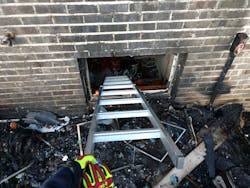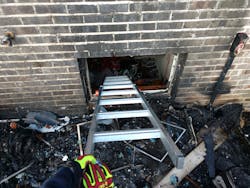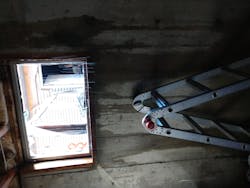Basement fires can be complex and challenging incidents. Basements typically have limited means of entry, egress and ventilation. Many are finished by homeowners. Although the layout that the homeowners might create works very well for them, it quickly can become a trap for firefighters.
The danger of basement fires is complicated further by unprotected engineered floor joists, which can result in the rapid failure of floor assemblies.
You must be ready to react when a company finds itself in trouble in a basement. Deploying ground ladders before the trouble emerges is just as important.From the bottom up
Consider this: Engine 2 arrives on scene of a single-story ranch with smoke showing. After a 360 size-up, the company officer confirms a working fire in the basement.
The company deploys the standard complement of tools to accomplish the task at hand: thermal imager, a set of irons and a hoseline. The engineer establishes a water supply and charges the primary attack line. Now what?
Attention must be afforded to deploying ground ladders—yes, ground ladders on a single-story residential structure. A single-story structure that has a basement actually is a multistory structure. It just happens that one of those stories is below grade.
Ground ladders have several uses beyond reaching upper floors.
Ground ladders must be readily accessible in the event that the first-due company enters the structure and falls through the floor into the burning basement. The interior crew has no orientation to where the stairs or exits are. Fast deployment of the ladder might give the entry crew a quick exit path or the RIT a quick entry path.
Ground ladders can be deployed on compromised stairs to distribute the weight or even serve as temporary stairs.On the interior
Deploying a ladder on the interior of a structure can be challenging depending on the location of the stairs.
In cases where the landing is large enough, a downed firefighter can be placed on the bottom couple of rungs on the ladder, and the members of the RIT can pull the ladder up the stairs with the downed firefighter on the ladder.
Ground ladders can be deployed to serve as exit stairs to assist crews to withdraw from the structure through basement windows. For apparatus that carry a multipurpose ladder, the outside ladder sections can be removed to create a shorter, lower profile ladder.
Ground ladders can be placed around a hole in the floor on the first level to disperse firefighters’ weight as they bring up a fellow firefighter through the hole.
Life or death
Maydays can be complex events, particularly from basements. Ladders that are deployed off of the truck and pre-staged in the front of the fire building might mean the difference between life and death for a firefighter who falls through the floor.
Additional Resources for Basement Fire Tactics
UL’s Fire Safety Research Institute (FSRI) and the International Society of Fire Service Instructors (ISFSI) collaborated on the Understanding and Fighting Basement Fires project. The goal was to reduce risk to firefighters by better understanding why these events occur and how firefighters can avoid injury. The study goes beyond past research by increasing the size of the basement and incorporating three access conditions to the basement.
FSRI’s “Understanding and Fighting Basement Fires” is a free 90-minute online course on firefighting at basement fires using modern fire tactics. For more information: fsri.org/research/understanding-and-fighting-basement-fires.
The ISFSI’s “Understanding & Firefighting Basement Fires” course is an eight-hour classroom session. Participants are guided through a review of the core principles of compartment fire development, modern terminology and research methods, and PPE limitations. For more information: isfsi.org/p/cl/et/cid=1056.
Multipurpose Ladders
Multipurpose ladders are one of the products that can be found at big-box home improvement stores that can enhance the safety of firefighters on the fireground. When NFPA 1931: Standard for Manufacturer’s Design of Fire Department Ground Ladders was revised in 2020, multipurpose ladders were included. Philadelphia Fire Department Paramedic/Lieutenant William Finegan participated in the revision of NFPA 1931 and wrote about the revision in Firehouse Magazine’s April 2021 NFPA Standards column: “NFPA 1931: Nontraditional Ladders and Accessories”.
About the Author

Brian Gettemeier
Brian S. Gettemeier has been in the fire service for 31 years, the past 28 years as a career firefighter with the Cottleville Fire Protection District of St. Charles County, MO, where he serves as an engine company captain. He is a member of St. Louis Metro Urban Search and Rescue Task Force 1. Gettemeier is a second-generation firefighter. He has a bachelor’s degree in fire service management from Southern Illinois University and holds numerous state certifications. Gettemeier teaches all-hazard classes for numerous municipal and industrial organizations throughout the states of Missouri and Illinois. He presented at Firehouse Expo multiple times.


